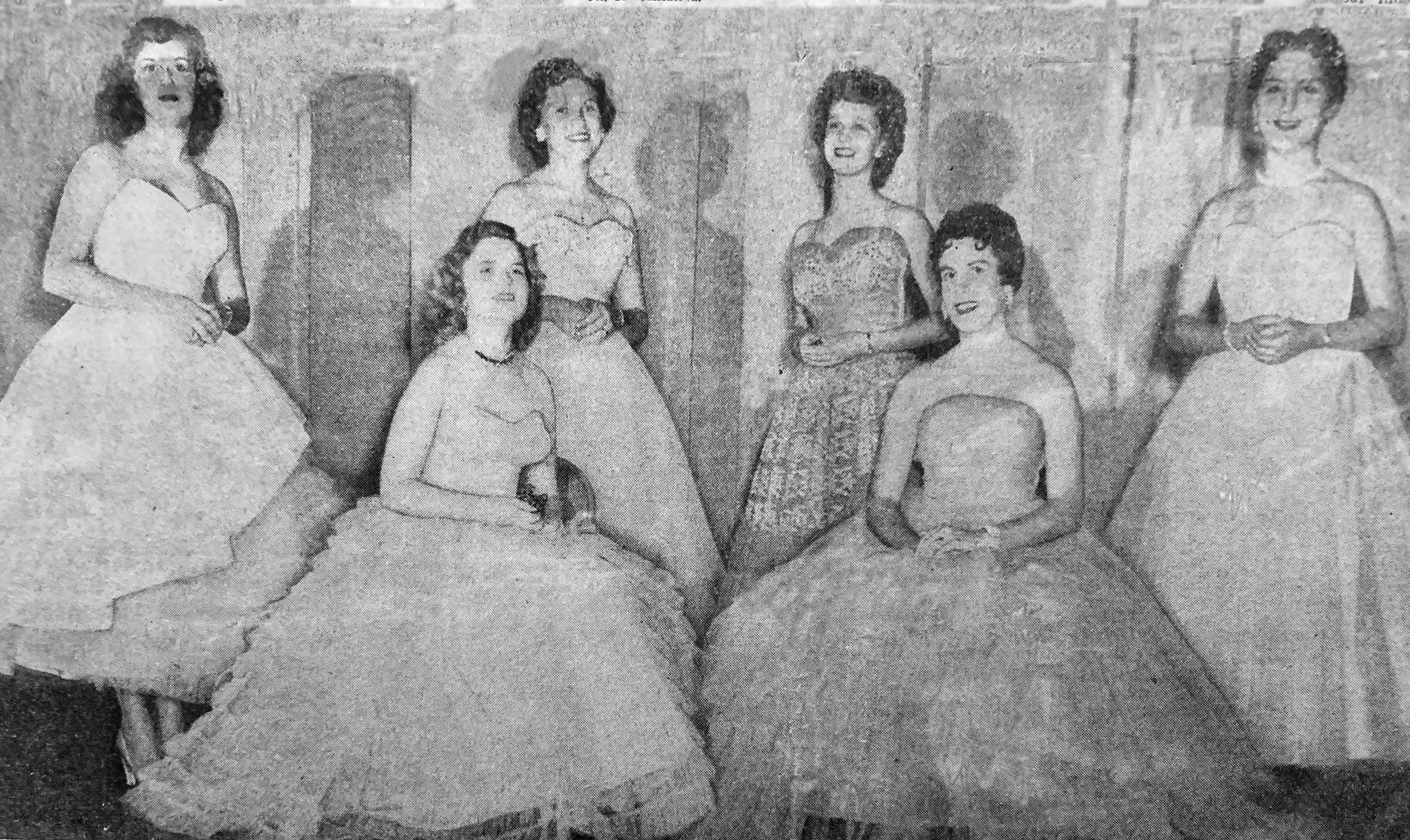GreeneScene of the Past
First Coal Queen and Her Court
By Colleen Nelson
When it comes to old photos there’s that perfect sweet spot – old enough to be nostalgic but still remembered and everyone in the photo is identified. This snapshot in time from the Pittsburgh Sun Telegraph has it all – it’s October 15, 1954, the first Coal Queen has been chosen and “Thousands Jam Carmichaels For Celebration.”
The third girl standing from the left, Miss Anna Mae Wancheck, will be crowned on Saturday night, the Friday morning cut line tells us. “Aides” Sondra Titus of Carmichaels, Dolores Janus of Jefferson and Charlotte Yaromy of Mt. Morris stand beside her, Henrietta Knight of Garrison and Sandy Hoy of Waynesburg fill the front row with crinoline, satin and picture perfect smiles. Those gowns let us know these are the Happy Days.
When Carmichaels Chamber of Commerce and the fire companies of Carmichaels, Nemacolin and Crucible formed the King Coal Association in 1953, long wall mining was coming into its own and coal was still the economic driver of the area. Time to throw a block party to celebrate the proud history of coal mining with an eye to the future, with its new extraction techniques, advancements in equipment and safety regulations geared to make the hard work of mining a little less dangerous.
The first show happened the next year and a queen was chosen from the six Greene County high school girls who applied. The only stipulation was that they be from a coal mining family. That first learn as you go year there was no talent show or essays to read.
“They put on gowns and went in and talked to the judges and the judges picked the one they liked the best – I guess! Things have changed since then,” Linda Rush tells me as we peer at old photos and giggle over the parade of hairstyles 50-some years of coal queen photos have on display.
Brice and Linda Rush have been in the thick of the show for more than 30 years and their house and outbuildings, including an old log cabin Brice repurposed in the front yard are full of the history of coal, from the pick and shovel days through the union building, coal patch living, layoff cycles and economic boom times of the last 120 years. If you want to learn about coal mining, this is the place to go.
In 2014 the King Coal Association put together a 50th anniversary book celebrating the coal show, its coal queens, floats, parades, demonstrations and fun and games, including car shows and carnivals behind the fire hall and bingo going on inside. The book features every queen through 2013, with plenty of photos of the floats they road on. But this newspaper page from 1954, hanging on Brice Rush’s wall, gives the kind of detail that makes this first festival come alive. And the faded photo of those first girls, with dads and brothers in the mines is a classic moment to remember.
There were fireworks on the Cumberland Township football field to kick off the festival Wednesday night, after a day of speeches and presentations. Senator Duff was there and so was a representative for John L. Lewis, legendary warrior of the UMWA. Fire companies fired up their hoses for “the Battle of the Barrel, a highly popular and original event.” and the U.S. Bureau of Mines did daily demonstrations of “coal mine dust explosions” that were, according to Brice, as loud as dynamite being set off.
“The Coal Festival at Carmichaels is the first such event in the history of Pennsylvania,” the article tells us. It also lauds the fact that the county has more unmined bituminous coal than any other county in the state and that Carmichaels is the hub of a network of operating mines that includes the largest one of all –“the gigantic Robena mine of U.S. Steel.” It’s Greene County coal that keeps the lights on in Pittsburgh and elsewhere across the regional grid of “a modern industrial metropolis.”

Brice tells me that those early coal queens didn’t necessarily go underground although they all posed with picks, shovels and overalls in front of the shaft at some point in their year of reign. But Anna Mae did go down in the mantrap – her dad was superintendent of the Bobtown’s Shannopin mine.
The coal queens of today don the gear that miners now wear for protection and descend into that underground world of industrial extraction. They get to watch the continuous miners chew coal from the seam and send it to the top on conveyor belts and when they emerge their faces are dark with the coal dust that made them queen.
On August 18, Holly Lesko will hand over her crown to the new coal queen and the stage will be set for another year of celebrating the past with an eye to the future of the economy of this region. And Brice will have just some of his vast collection of coal memorabilia on display in the fire hall for those who come to the 2019 King Coal Bituminous Coal Show. I’ll see you there!
